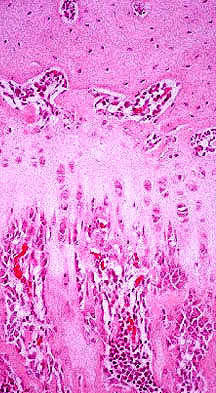 Specialized
connective/supporting tissues include cartilage and bone, which are
closely related in structure and function. Specialized
connective/supporting tissues include cartilage and bone, which are
closely related in structure and function.
- In fact, most of the bone in the
body develops from a type of cartilage, as we will study in the
next lab.
- Both cells and fibers are
prominent in most kinds of these supporting connective tissues,
but the relative rigidity of their matrices is the special
quality that distinguishes them from other types of connective
tissue.
- In spite of their similarities,
however, cartilage is distinguishable from bone on the basis of
matrix hardness, density and avascularity.
- Unlike cartilage, bone has a
more extensive set of cell types, extracellular specializations
for calcification, and the presence of blood vessels, all of
which allow for more extensive possibilities for the tissue’s
development and remodeling.
Learning Objectives for this unit:
- Understand the variations in
structure and function of the three major types of cartilage,
with regard to both the cellular and extracellular elements.
- Understand the key
ultrastructural features of the chondroblast and how they relate
to function.
- Understand the structural
features and functions of osteogenic cells, osteoblasts,
osteocytes, and osteoclasts.
- Know the major differences in
structure and function between woven and lamellar bone, and
between compact and cancellous bone.
- Understand the structure and
composition of an osteon and how it is formed.
Let's take a look at some tissues. |